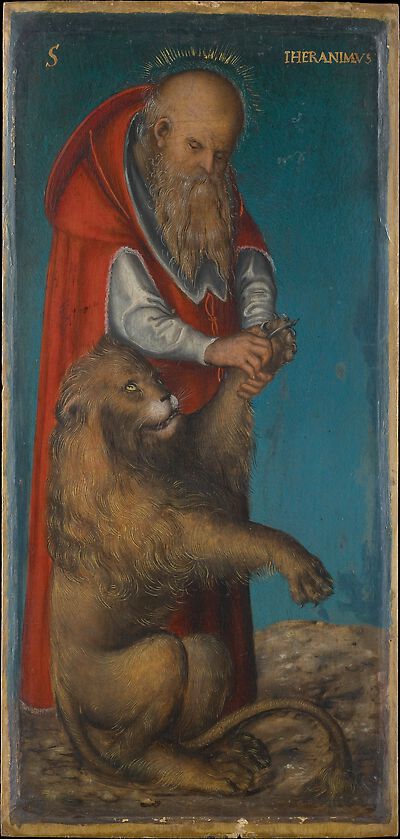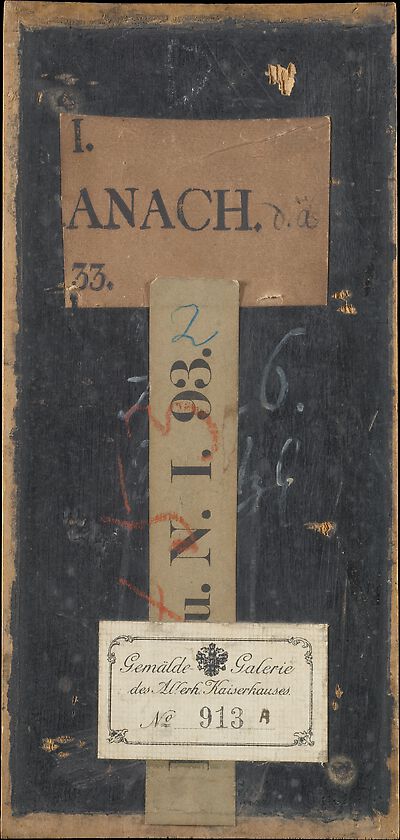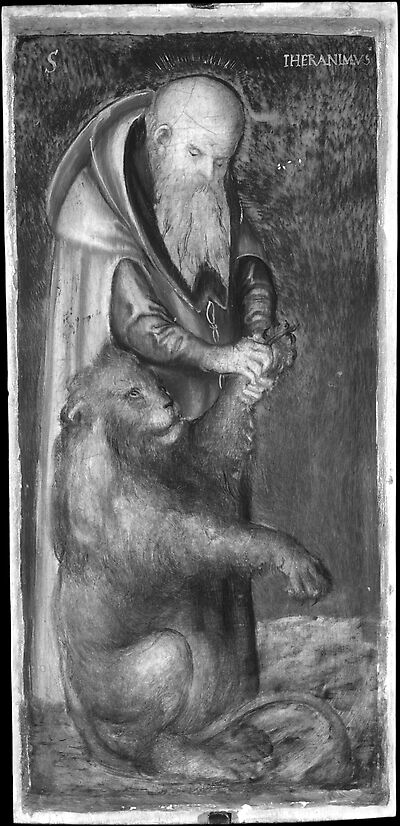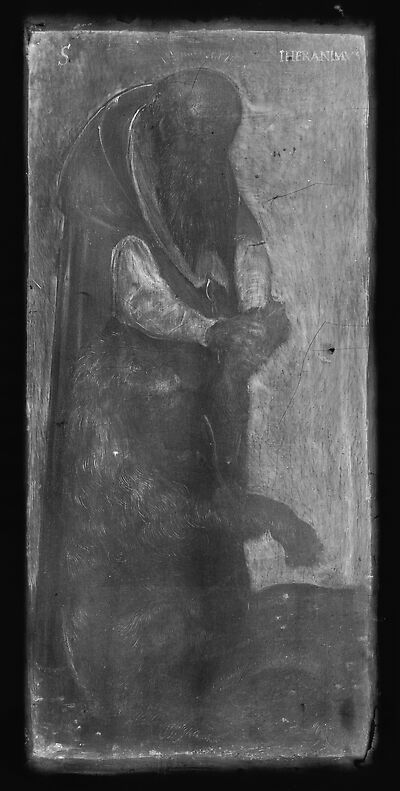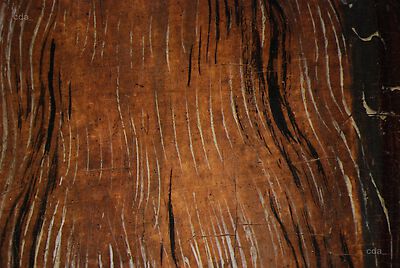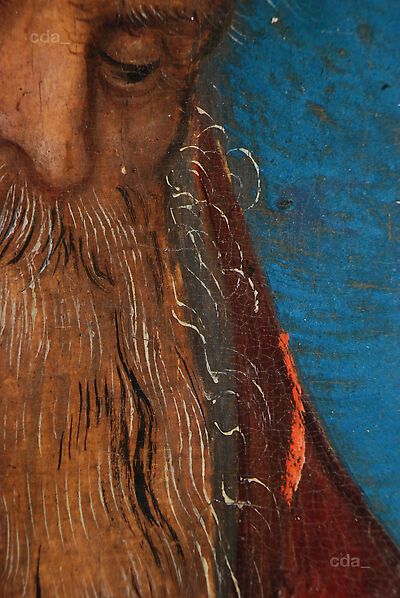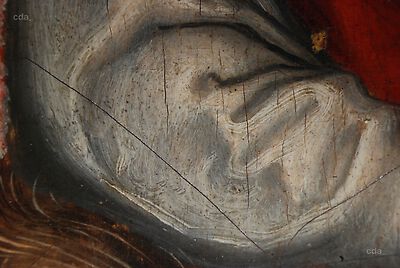- Attributions
-
Lucas Cranach the Elder
Workshop Lucas Cranach the Elder
Attributions
| Lucas Cranach the Elder | [Kunsthistorisches Museum, revised 2011] |
| Workshop Lucas Cranach the Elder | [Exhib. Cat. Kronach 1994, No. 212a] |
- Production date
- 1515
Production date
| 1515 | [Pendant dated] |
- Dimensions
- Dimensions of support: 24.5 (l.) 24.4 (r.) x 11.6 (b.) 11.5 (t.) cm
Dimensions
Dimensions of support: 24.5 (l.) 24.4 (r.) x 11.6 (b.) 11.5 (t.) cm
Dimensions of the painted surface: c. 22.9 x 10.8 cm
Dimensions including frame: 29.9 x 17.9 (or 35.9 framed together with AT_KHM_GG913b) x 1.9 cm
[Kunsthistorisches Museum, revised 2011]
- Signature / Dating
Pendant signed and dated
Signature / Dating
Pendant signed and dated
[Kunsthistorisches Museum, revised 2013]
- Inscriptions and Labels
-
above the figure: 'S IHERANIMVS'; in yellow paint Reverse of the panel:
-
top centre:
in white chalk 'D' -
across both panels …
Inscriptions and Labels
Inscriptions, Badges:
- above the figure:
'S IHERANIMVS'; in yellow paint
Stamps, Seals, Labels:
Reverse of the panel:
- top centre:
in white chalk 'D'
- across both panels (AT_KHM_GG_913a and AT_KHM_GG_913b):
printed paper label: '[C.]I. / [LUC. CR]ANACH. / [Nro.] 33.', handwritten addition: 'd. ä.', (information in square brackets is on the reverse of AT_KHM_GG_913b)
in pencil: 'XX'
- right of centre:
in pencil: 'X'
in white paint: '[...] 6' and '39 [...]3' (upside down)
- centre, vertical (partially covered by inventory label):
printed paper label: '[II. D.] u. N. I. 93.' handwritten addition in blue paint:
'2', on this in red chalk: '(..) 453'
Inventory label: 'Gemälde-Galerie des Allerh. Kaiserhauses, No 913'
- bottom centre:
handwritten addition in dark pen: 'A'
[Kunsthistorisches Museum, revised 2013]
- Owner
- Kunsthistorisches Museum, Vienna
- Repository
- Kunsthistorisches Museum, Vienna
- Location
- Vienna
- CDA ID
- AT_KHM_GG913a
- FR (1978) Nr.
- FR068
- Persistent Link
- https://lucascranach.org/en/AT_KHM_GG913a/
-
Provenance
-
first mentioned in the Imperial Collection in Vienna, inventory of the clerical treasury from 1756 under No. 25 and No. 26.
[source: Inventar der Geistlichen Schatzkammer, verfasst am 23. Februar 1758: "25. Der heilige Leopoldus von Cranich. 26. Dessen compagnion, der heilige Hieronymus. (25. St Leopold by Cranich. 26. His companion St Jerome)" Published in: Zimmermann, Heinrich: Reg. Nr. 12623 - Inventar der Geistlichen Schatzkammer (Kunsthistorisches Museum, Wien, Kunstkammer). "Nun folgen die in dieser geistlichen Schatzcammer befindliche bilder [...]" 23. Februar 1758. In: Jahrbuch der kunsthistorischen Sammlungen des Allerhöchsten Kaiserhauses, 1895, Jg. 16, p. XXV-XXVI., S. XXV. The numbers corespond with the inscriptions (in white paint) on the reverse of the panels 'Nr. 25' verso AT_KHM_GG913b (St Leopold) and 'N[...]6' verso AT_KHM_GG913a (St Jerome).] -
from 1781 it was mounted together with AT_KHM_GG913b in a frame and displayed in the Imperial Picture Gallery in the Belvedere, Vienna.
[source: Christian von Mechel, Cat. Vienna 1783, 240, No. 29] -
from 1792 in the Picture Gallery of the Kunsthistorisches Museum
[source: Cat. Vienna 1892, No. 1537]
[Kunsthistorisches Museum, revised 2013]
Exhibitions
Graz 1953
Vienna 1972, No. 3
Berlin 1983
Literature
| Reference on page | Catalogue Number | Figure / Plate | |||||||||||||||
| Exhib. Cat. Kronach 1994 | 380, 381 | 212a | |||||||||||||||
|
|||||||||||||||||
| Schade, Schuttwolf 1994 | 17 | ||||||||||||||||
|
|||||||||||||||||
| Cat. Vienna 1991 | 46 | Plate 588 | |||||||||||||||
|
|||||||||||||||||
| Exhib. Cat. Klosterneuburg 1985 | 250 | under No. 231 | |||||||||||||||
|
|||||||||||||||||
| Exhib. Cat. Berlin 1983 | 80 | No. B5 | Fig. B5 | ||||||||||||||
|
|||||||||||||||||
| Friedländer, Rosenberg 1979 | 83 | 68 | Fig. 68 | ||||||||||||||
|
|||||||||||||||||
| Schade 1974 | 85 | ||||||||||||||||
|
|||||||||||||||||
| Cat. Vienna 1973 | 48 | Plate 130 | |||||||||||||||
|
|||||||||||||||||
| Exhib. Cat. Vienna 1972 | 19 | No. 3 | Fig. 1 | ||||||||||||||
|
|||||||||||||||||
| Exhib. Cat. Graz 1953 | 23 | No. 26 | |||||||||||||||
|
|||||||||||||||||
| Cat. Vienna 1938 | 41 | No. 1453 | |||||||||||||||
|
|||||||||||||||||
| Friedländer, Rosenberg 1932 | 41-42 | 60 | |||||||||||||||
|
|||||||||||||||||
| Cat. Vienna 1928 | 56 | No. 1453 | |||||||||||||||
|
|||||||||||||||||
| Baldass 1922 B | 80 | ||||||||||||||||
|
|||||||||||||||||
| Cat. Vienna 1907 | 336 | No. 1453 | |||||||||||||||
|
|||||||||||||||||
| Flechsig 1900 A | 12 | ||||||||||||||||
|
|||||||||||||||||
| Exhib. Cat. Dresden 1899 | 111 | ||||||||||||||||
|
|||||||||||||||||
| Cat. Vienna 1896 B | 423 | No. 1453 | |||||||||||||||
|
|||||||||||||||||
| Cat. Vienna 1892 | 387 | No. 1537 | |||||||||||||||
|
|||||||||||||||||
| Scheibler 1887 | 297 | ||||||||||||||||
|
|||||||||||||||||
| Cat. Vienna 1886 | 49 | No. 1476 | |||||||||||||||
|
|||||||||||||||||
| Waagen 1866 | 176 | ||||||||||||||||
|
|||||||||||||||||
| Cat. Vienna 1858 | 124 | No. 93 | |||||||||||||||
|
|||||||||||||||||
| Schuchardt 1851 A | 10, 66 | ||||||||||||||||
|
|||||||||||||||||
| Schuchardt 1851 C | 136-137 | 427 | |||||||||||||||
|
|||||||||||||||||
| Cat. Vienna 1837 | 216 | No. 93 | |||||||||||||||
|
|||||||||||||||||
| Heller 1821 | 228 | ||||||||||||||||
|
|||||||||||||||||
| Cat. Vienna 1783 | 240 | No. 29 | |||||||||||||||
|
|||||||||||||||||
Research History / Discussion
Discription: On the left panel St Jerome is depicted as a bearded old man wearing a red cardinal’s cassock and pulling a thorn out of the paw of a lion that sits on his hind legs in front of him.
The saints, that were conceived together, stand on stony ground against a blue background. The uniform background and the inscriptions indicate that the paintings are pendants, and that they perhaps served as the inner wings of a small altarpiece, which no longer exists.
Iconography: St Jerome is shown as a single figure healing the lion: the animal seeks his assistance and he pulls a thorn out of its paw.[1] The unusual position of the animal is similar to that in representations which would have been familiar to Cranach, for example the rendition of a silver reliquary statue in the ‚Wittenberg Heiligtumsbuch‘ or a large panel with saints in Aschaffenburg.[2]
Research History: The small images of the saints from the clerical treasury have been a permanent fixture in the first room of the Early German School since the earliest installation of the Imperial Picture Gallery in the Belvedere.[3] The clearly legible characters of the signature and the date were already observed by Schuchardt and were taken as a point of reference for further research: he noted an orientation towards Dürer, which may be accounted for by the cooperation on the drawings in the margin of Emperor Maximilian’s prayer book in the same year.[4] Hereafter it was repeatedly pointed out that early dated paintings by Cranach, like the ones discussed here, are rare.[5] The catalogue entry from 1928 suspects, with reference to the concurrent work for Emperor Maximilian’s prayer book, that the winged altarpiece was commissioned by an Austrian because of the depiction of St Leopold.[6] Schade suggests that it could have been a present from Friedrich the Wise to Emperor Maximilian. He refers to a representation of a silver statue of St Jerome in the Wittenberg Heiltumsbuch from 1509 as an exemplary depiction of the saint: inverted but the position of the lion is identical.[7] The representation of St Leopold was evidently not among Cranach’s repertoire of forms as was observed in the catalogue of the Lower Austrian Landesausstellung from 1983: the ducal hat and the cloak differ from the prevaling depictions of the saint at that time.[8]
Whereas the gallery catalogue from 1928 and later publications by the museum classify the panels as ‚autographic‘ paintings by Lucas Cranach the Elder, Schade remarked that they were less meticulously executed panels from the Cranach workshop.[9]
Discussion:
Both panels have been preserved in their original size but the original frame was lost at some unknown date. On the panels there is no indication of the original assembly and consequently the designated use. The reverse of both panels exhibit a very old possibly original black coating. This side was presumably not intended for viewing, as it would otherwise feature marbling or some other embellishment. Therefore it remains open whether the panels served as wings of a small altar or whether they had another function.
[Tüchler, Hoppe-Harnoncourt, Kunsthistorisches Museum, 2013][Translation, Smith, cda 2013]
[1] LCI (Lexikon Christlicher Ikonographie), Bd. 6, 1974, Sp. 521.
[2] Jahn, Johannes: Lucas Cranach d. Ä. 1472 – 1553. Das gesamte graphische Werk mit Exempeln aus dem graphischen Werk Lucas Cranach d. J. und der Cranachwerkstatt, Munich 1972, Fig. p. 487; follower of Lucas Cranach the Elder, about 1520, „St Jerome“, Aschaffenburg, Bayerische Staatsgemäldesammlung, Inv. 12369 (Fig. of “St Jerome”, in: Cranach Digital Archive <http://www.lucascranach.org/digitalarchive (4.11.2013) CDA Inv.: DE_BStGS_ DE_BStGS_12369.
[3] Mechel, Christian von: Verzeichnis der Gemälde der kaiserlich königlichen Bilder Gallerie in Wien […] nach der von ihm auf allerhöchsten Befehl im Jahre 1781 gemachten neuen Einrichtung. Vienna 1783, p. 240, No. 29.
[4] Schuchardt, Christian: Lucas Cranach des Aeltern Leben und Werke. Erster Theil. (3 Bände) Leipzig 1851, p. 10, 66.
[5] Scheibler, Ludwig: Über altdeutsche Gemälde in der kaiserlichen Galerie zu Wien. In: Repertorium für Kunstwissenschaft, 1887, Jg. 10, p. 271–306, p. 297.
[6] Kunsthistorisches Museum: Katalog der Gemäldegalerie. 1. Auflage (Führer durch die Kunsthistorischen Sammlungen in Wien, 8), Vienna 1928, p. 56, No. 1453.
[7] Werner Schade in: Kroll, Renate; Flügel, Katharina (ed.): Kunst der Reformationszeit. Ausstellung. Martin-Luther-Ehrung 1983 der Deutschen Demokratischen Republik. 26.8.-13.11.1983. Berlin-Ost 1983, p. 80, Cat. B5, Fig. B5. see Jahn, Johannes: Lucas Cranach d. Ä. 1472 – 1553. Das gesamte graphische Werk mit Exempeln aus dem graphischen Werk Lucas Cranach d. J. und der Cranachwerkstatt, Munich 1972, Fig. p. 487.
[8] Stift Klosterneuburg, Amt der Niederösterreichischen Landesregierung (ed.): Der Heilige Leopold, Landesfürst und Staatssymbol. Niederösterreichische Landesausstellung Stift Klosterneuburg, 30. März-3. November 1985 (Katalog des Niederösterreichischen Landesmuseums, n.F., No. 155), Vienna 1985, No. 231, Fig. 36.
[9] „Autographic“ among others in Kunsthistorisches Museum: Katalog der Gemäldegalerie. 1. Auflage (Führer durch die Kunsthistorischen Sammlungen in Wien, 8), Vienna 1928, p. 56, No. 1453 und Schütz, Karl (1972): Lucas Cranach der Ältere und seine Werkstatt. Jubiläumsausstellung museumseigener Werke 1472 - 1972. Vienna 1972, p. 19, Cat. 3, Fig. 1. In contrast Werner Schade in: Kroll, Renate; Flügel, Katharina (ed.): Kunst der Reformationszeit. Ausstellung. Martin-Luther-Ehrung 1983 der Deutschen Demokratischen Republik. 26.8.-13.11.1983. Berlin-Ost 1983, p. 80, Cat. B5, Fig. B5 and Schade, Werner: Die Malerfamilie Cranach, Dresden 1974, p. 85.
